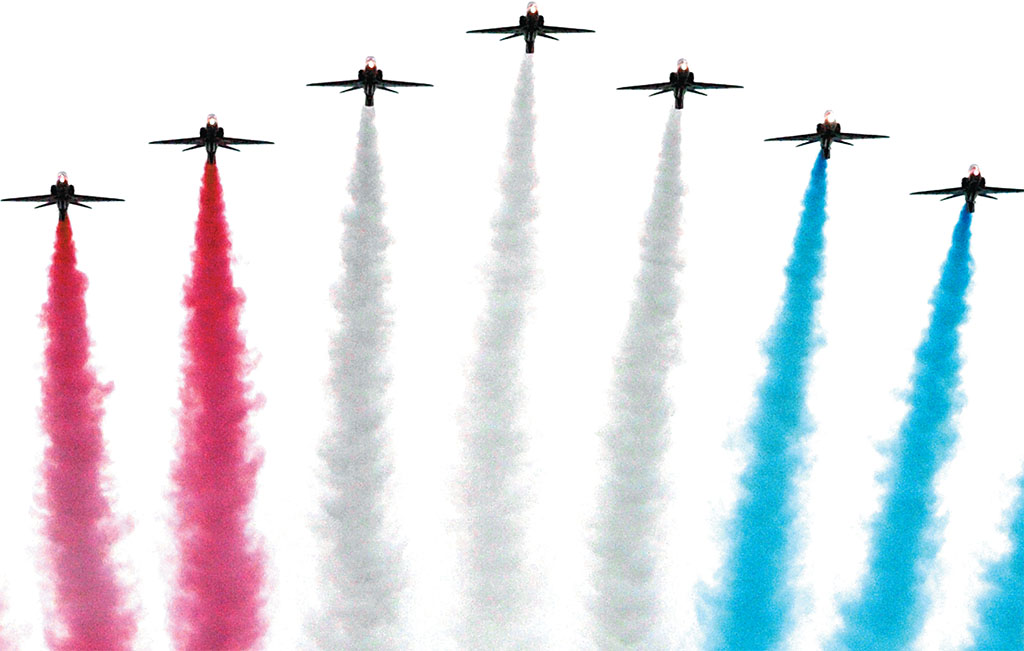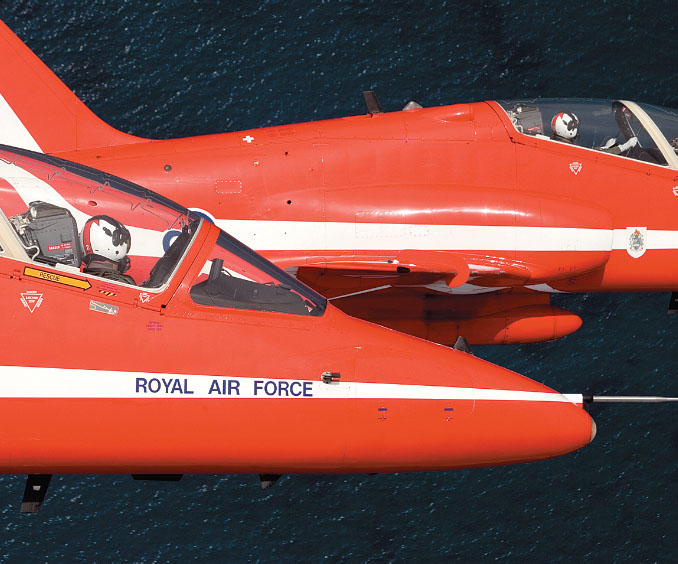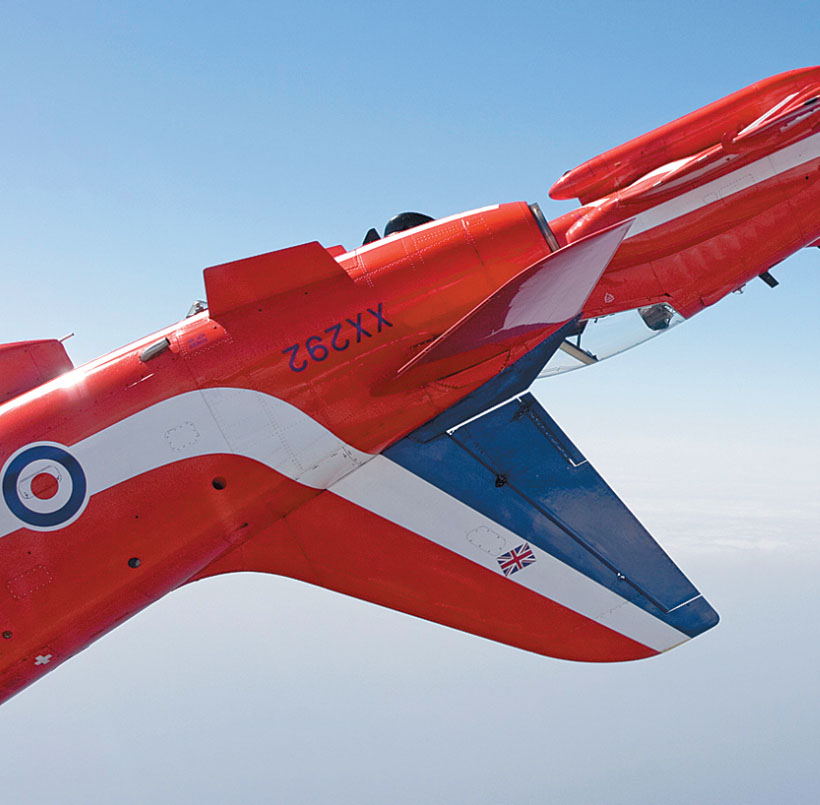
Since 1965, Britain’s RAF precision flying team has amazed audiences around the world
[caption id="IntotheSkywiththeRedArrows_Feature" align="aligncenter" width="1024"]

MICHAEL STEPHENS/PA WIRE/PA PHOTOS
THINK TENNIS AT WIMBLEDON and cricket at Lord’s, picnics at Glyndebourne and village fêtes strewn across the lawns of Old Rectories. But roaring through the heart of our British summers, you will always hear the hum of an engine.
Since the early displays in the 1920s at Hendon and Farnborough, air shows have been ubiquitous fixtures on the summer calendar, and their popularity shows no signs of wane. Air shows ignite an excitement and adrenalin rush that reaches all echelons of society, age and gender, and, being an island, our shoreline encloses the perfect performance space. Couple this with a proud heritage of aviation innovation, and British air shows are legendary. But there is something else that draws vast crowds and brings traffic to a standstill—something else that embodies the extremes of flight and excellence of teamwork. That is the Red Arrows—the Royal Air Force’s legendary formation aerobatic display team.
Renowned and respected worldwide as masters of formation display, the Red Arrows are prolific ambassadors for the RAF and the United Kingdom. Officially formed in 1965, the Red Arrows have flown more than 4,000 displays in 52 countries. “The Team” consists of nine pilots and 13 BAE Systems Hawk T1 aircraft backed by 100 dedicated and highly motivated RAF personnel. The Red Arrows’ reputation is enhanced by each team member’s professionalism, skill and commitment, honed by RAF training and resources.
Chatting across the wing of his red Hawk, Squadron Leader Martin Higgins told me: “Thousands work in the RAF and all of them want to achieve the best. The Red Arrows pilots are extremely fortunate to be the public face of that spirit.” With what must be one of the most thrilling jobs there is, Higgins exudes an infectious enthusiasm for his role that is palpable and quite obviously radiates from fellow teammates.
[caption id="IntotheSkywiththeRedArrows_img1" align="aligncenter" width="678"]

MICHAEL JORGENSEN
I wondered, did he harbor a childhood ambition to become a Red Arrow? “Yes, I did,” he admitted. “When I was a small boy, about 8 years old, I remember my father took me to an air show and I was enthralled! I knew then that I wanted to fly.” The path toward the prestigious red, white and blue vapor trail required hard work and focused commitment. “I studied aeronautics and astronautics at Southampton University and then joined the RAF aged 20,” he said. “Initially when I joined the RAF, it didn’t occur to me that I would ever be part of the Reds. The criteria for selection is experience-based. You need 1,500 hours on fast jets such as the Tornado or Jaguar and to be above average. My thoughts were to take small steps at a time, and suddenly I became eligible to apply and I got in!”
Those small steps involved becoming a qualified flying instructor on the Hawk—a dual controlled advanced trainer, before moving on to drive one of the ultimate fast jets, the Tornado F3. Higgins has flown operationally in Iraq and will probably return to a fast jet squadron when his time with the Red Arrows is up.
Higgins is in his third year with the Red Arrows and his second in the position of Red 9 at the rear of the nine-man display formation. Reds 1 to 5 form the front section, which is known by the term “Enid,” and Reds 6 to 9 are known as “Gypo.” Reds 6 and 7 perform the eye-catching opposition maneuvers.
Each display pilot performs for three years, and two or three new recruits join the team every year to ensure maximum expertise is retained and rotated. The selection process for the Reds is naturally thorough. All potential display pilots must not only withstand the pressures of rigorous training, which is essential to safe public performances, but must also fit in and complement the existing characters. Short-listed candidates endure a grueling flying test; they have to perform intricate maneuvers while maintaining a tight formation with another aircraft. Imagine flying less than 20 feet from the wing of an aircraft at speeds of up to 500 mph and while pulling 7G—an extreme test of nerves and precision! Candidates also have a formal interview before facing peer assessments.
Although nine pilots perform the displays, a 10th, or Red 10, flies to each show in case a backup aircraft is needed. Instead of flying the formation display, Red 10 provides the essential ground commentary to thousands of spectators.
Aerobatics and formation flying have long been at the core of RAF pilot training, enabling the pilots to develop complete confidence in their own abilities matched with those of their aircraft and fellow team members. The roots of the Red Arrows hark back to an RAF pageant held in 1920 at Hendon near London, when biplanes performed aerobatics for the crowd. Those propeller-powered biplanes metamorphosed into jet-propelled de Havilland Vampires, Hawker Hunters and Folland Gnats. In 1964 the Gnats in service were yellow, resulting in the bizarrely named “Daffodil Patrol” performing publicly. Fortunately a color change inspired a new identity and on May 6, 1965, at RAF Little Rissington in Gloucestershire, the Red Arrows performed for the first time. Hawks were introduced in the early 1980s, and six of the original aircraft remain in team service today—a feat that is testament to the meticulous maintenance and service that these flying machines undergo.
[caption id="IntotheSkywiththeRedArrows_img2" align="aligncenter" width="820"]

MICHAEL JORGENSEN
A fleet of 13 Hawks is available to the team. As Higgins explained:“A senior engineering officer structures the fleet management. We want them to last and be as cost effective as possible.” The 100-strong backup team helps to keep these jets airworthy and safe for display.
The Red Arrows have a punishing tour schedule, flying 85 dates in a season, up to two displays a day at locations hundreds of miles apart. The display routine lasts for 22 minutes and encompasses such maneuvers as the Champagne Split, Cyclone, Corkscrew and Opposition Barrel Rolls.
What is a favorite maneuver, I wondered? “It has to be the Corkscrew,” Higgins enthused. “The reason is that never in your air force career have you had cause to do it and then when you are told to do it you think ‘Wow! This is just brilliant!’ It’s good fun but safe.”
Aside from the worldwide performances and the winter training in Cyprus, the team also performs a flypast over London to celebrate the Queen’s Birthday in June. The pilots also find time to visit schools and talk to pupils about becoming Red Arrows. “You see their faces and they think it’s out of reach,” Higgins said. “But I tell them they can achieve it. It just takes small steps. I did it.”





Comments